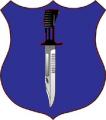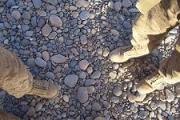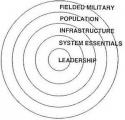At first, I decided to stay out of this thread, since OPSEC concerns were being raised, and at least a few denigrated the very topic as being at best irrelevant and at worst, amateurish.
Yet, how often have all of us heard "train as you fight, and fight as you train"...?
Someone, somehow, must decide what vehicles will be in your motorpool, how many weapons and of what type must be in your armsroom, how many officers, NCO's, and troopies you are supposed to have (and sometimes, those numbers actually do match up with reality).
...and while that obviously doesn't solely determine how you will train, it darn sure has a real impact.
Besides, arguing over organizations is fun, as long as everyone realizes that it is just one detail of the endless multitude of details that determine success or failure on the battlefield... possibly because organization is so easily analyzed, as opposed to concepts like doctrine, leadership, and training, which of course play a much larger role.
So, to cavalierly disregard the "it depends on the situation" argument, and drastically simplify things, I'll just wade in and draw fire…
Beginning with artillery (which some may decry as being totally irrelevant to “small wars”):
If you expect to see a decent amount of combat, then you want artillery, if for nothing else than "just in case".
It can be thought of as a reserve of (near) instantly applicable combat power. A battalion commander can dispatch a reserve platoon to reinforce a unit in contact, and it may take them the better part of an hour to get there, while artillery can affect the fight within minutes, or even seconds.
For this reason, I believe that every commander, from Company level up, should have their own artillery, organic to their organization (so that he will actually *have* it when he needs it).
Artillery must have enough range to sit behind the combat platoons, and reach out to targets beyond those platoons (and any scouts /recon elements the commander has out there, hopefully). Artillery, thus far, must be stationary to fire, and requires at least some time to emplace ("set up"), and thus maneuver units can easily "outrun" their fire support. The other major consideration is how much the ammo weighs, since even with precision munitions, you may need generic suppressive fires, or smoke screens, and those fire missions still require plenty of ammunition...
At the company level, since we generally expect an infantry company to be able to walk places that vehicles can't go, we are limited to mortars. 81mm mortars can be "humped", but it is unpleasant (heh, the TOW missile launcher can theoretically be humped, too, and I knew an 11H sergeant who was in an AT platoon ordered to do it once, he said it was the most pathetic thing that he ever saw...) 60mm mortars are lighter, the ammo is lighter, and with 3 or 4,000m range, have enough range, as long as the company is grouped tightly together. If you are humping the mortar tubes, you probably have to hump the ammo, too (the alternative is a sling load under a helo, or parachute supply). In an attack, even if every grunt in the rifle company carries two rounds, and dumps them off at the firing point, that still isn’t much (60mm mortars have a murderous rate of fire, up to 20 or 30 rounds/minute). So having say, six mortars down at company level wouldn’t do much good, as you would just burn through the ammo supply unnecessarily fast, and then be left with 6 metal tubes doing nothing. The U.S. Army has two tubes at company level, the USMC has three; I’d say three is better – allowing you to pump out rounds fast enough, or alternatively to “chop” one to each of the three rifle platoons. In the mech world, a section of three 120mm mortars is enough to build a useful smoke screen even in unfavorable conditions, and the range is (barely) sufficient to support the platoons.
At battalion level, you need more reach to be able to range in to support the line companies, and (theoretically) it is easier to keep them supplied with ammunition. Most have a platoon of 81mm (if you need to hump the tubes), or 120mm mortars (if you can use vehicles to tow them around), and a battery of howitzers habitually attached. If it were me, instead of a platoon of 4-6 mortars and a battery of 6-8 howitzers, I’d just have one large battery organic to the battalion, with 8 to 12 crews and howitzers, along with perhaps 6-8 120mm or 81mm mortars for when the howitzers can’t be used. It has been shown that artillery crews can rapidly transition from using one type of ordinance to another (with 2-3 weeks of training). On average, howitzers require only one or two additional crewmen, and it is easy to concoct scenarios where the artillery of a battalion must be called on for targets exceeding the 6 or 7km range of most mortars. (I can already hear the howls that will come from this over-simplification…)














Bookmarks